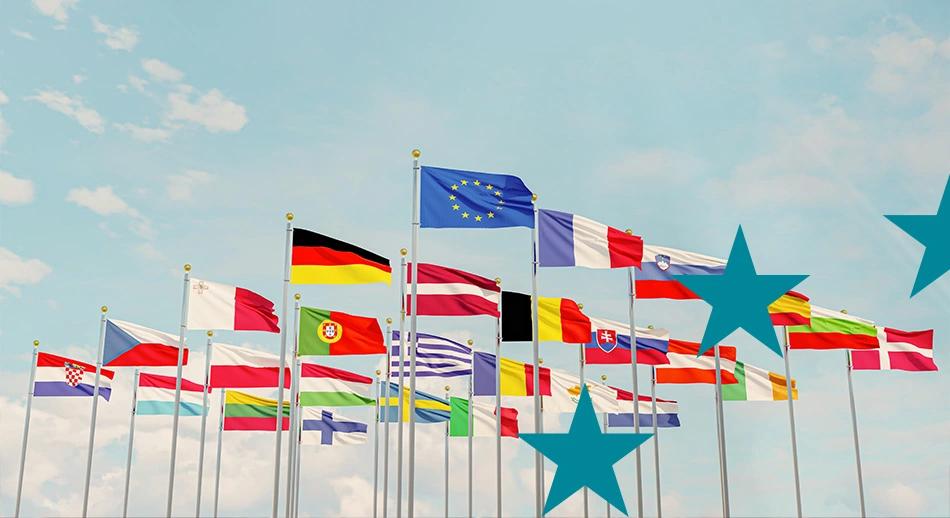The new EU Multiannual Financial Framework for 2028-2034 has been presented. Let’s find out the main new features together.
Multi-year financial framework 2028-2034: a kickoff
On July 16, 2025, the European Commission’s proposal for the new EU Multiannual Financial Framework, the long-term budget that will cover the seven-year period from 2028 to 2034, was officially presented. This budget defines the Union’s spending lines, the framework within which all annual EU budgets will be placed, and – in particular – the architecture and resources of EU funds and programs for the seven years of the next programming period. The total amounts to about 2 trillion euros, corresponding to 1.26 percent of the EU’s gross national income (calculated on the projected average 2028-2034).
This proposal marks the start of the approval process, which is likely to continue for the next two years, with negotiations and discussions to get the green light from the European Parliament and the European Council. Precisely for this reason, it is worth remembering that this proposal for the Multiannual Financial Framework (MFF) is a starting point, which may be subject to major changes over the course of two years of negotiations, which promises to be particularly lively.
The approval procedure for the MFF (and the broadly understood EU budget) is explained in detail in our dedicated article.
Let us now analyze some of the most salient aspects and most important innovations introduced in this first draft of the MFF, outlining some of the possible spillovers, particularly with regard to the distribution of Structural Funds and funds related to directly managed programs.
MFF 2028-2034: a first overview
An initial analysis of the Commission’s proposal for the new MFF reveals some important new features:
- An increase in the total resources available to 1984 billion euros, compared to 1200 billion in the 2021-2027 seven-year period. A significant increase, even considering that these resources also include about 168 billion needed to repay the resources invested in NextGenerationEU;
- A comprehensive restructuring of the architecture of European funds and programs, with the intention of fostering a more agile and effective management of resources. This specifically translates into:
- In a reduction of the headings (i.e., expenditure categories into which the EU budget is organized) from 7 to 4,
- In a decisive reduction in the number of programs funding (from 52 to 16, with harmonized rules),
- In a different management of the programming of the Structural Funds and shared management.
There are also plans to adopt a single portal, which will be a single point of access to all funding opportunities. We will keep you updated on all these developments and changes in commonly used tools, such as the Funding & Tenders portal;
- Greater flexibility and accessibility in the use of European funds, through the harmonization of rules and conditions of access and a flexibility instrument that will make it easier to divert resources to new needs: a significant share of MFF resources will not be pre-programmed or planned;
- A strengthening of the principles of the Charter of Fundamental Rights of the European Union and the Rule of Law (already provided for in the current conditionality regulation), with the possibility of suspending funds to Member States in case of violation, the possibility of reallocating them to other programs, and a system of incentives and financial support for civil society organizations;
- New instruments to finance the new long-term budget and to repay loans under NextGenerationEU, through a package of five new own resources. As we explain here, the definition of own resources is one of the key steps in the approval of the MFF.
MFF 2028-2034: the allocation of resources
MFF resources are distributed within headings, or categories of expenditure. These headings are the same in which the general overview of European programs on our Guide is organized. The MFF proposal envisages a reduction of these headings from 7 to 4: we offer a brief description of them, highlighting the main changes.
1. Economic, social and territorial cohesion of Europe, agriculture, rural and maritime prosperity and security. This heading incorporates the largest number of resources, with a total allocated to projects of 894.2 billion euros. It includes resources dedicated to the Cohesion Policy and the Common Agricultural Policy (453 billion euros). Resources for the Common Agricultural Policy are reduced by about 30 percent compared to the previous programming.With the aim of fostering more effective, flexible and targeted management and disbursement of EU funds, specific National and Regional Partnership Plans are introduced with which each member state identifies specific investments and reforms to meet its development needs. In the European Commission‘s intentions, the national and regional plans cover not only Cohesion Policy and the CAP, but also social policy (to which a minimum of 14 percent of the plan’s allocation is to be dedicated), maritime and fisheries policy, migration and homeland security. The idea is to move from more than 500 programmatic documents(each region’s PR and sectoral NPs) to 27. This heading includes 10 billion euros for Territorial Cooperation (Interreg programs). Finally, the heading includes funds to repay debts incurred by the European Union for the financing of NextGenerationEU, bringing the total envelope of this heading to 1 trillion euros.
2. Competitiveness, prosperity and security. The second heading includes an allocation of 589.6 billion euros, plus 41.2 billion from the Innovation Fund. This heading specifically provides for a large new European Competitiveness Fund (409 billion euros), to which many of the current directly managed programs will be returned and declined in 4 areas:
- Clean transition and decarbonization (about 11 percent of the Fund);
- Digital transition (about 22 percent of the Fund);
- health, biotechnology, agriculture and bioeconomy (about 9 percent of the Fund);
- defense and space (about 53 percent of the Fund).
Approximately 5 percent of the Fund will be allocated to cross-cutting activities and its general objectives (e.g., investment, SMEs, etc.).
The main European programs currently active that will continue to exist within this heading are:
- Horizon Europe, which remains the main directly managed program in research and innovation. This program is strengthened, with a budget of 175 billion from the 95.5 billion allocated in 2021-2027;
- Erasmus+, which will turn a full 40 years old in 2027. An auspicious number as the program sees a marked increase in resources, with 40 billion compared to 26 billion in the previous seven-year period;
- CERV and Creative Europe programs, which are being channeled within the new AgoraEU program.with total resources of about 8 billion euros, double the amount provided in 2021-2027 for the two previous programs.
For the LIFE program and other directly managed programs (e.g., EU4Health, Digital Europe, Single Market Program), the situation is more uncertain: they will be absorbed within this heading, and in particular within the new European Competitiveness Fund (see the 4 areas mentioned above and their indicative allocations), in ways that will have to be better defined.
3. Global Europe. The third heading is devoted to the Global Europe program, the EU’s flagship instrument for external cooperation and development cooperation with candidate, third and neighboring countries. The program is thus confirmed, with a significant budget increase: 215.2 billion euros, up from the previous 79.5 billion. The program budget includes a reserve of 15 billion for crisis response mechanisms and unexpected events. An important change is the new distribution of resources, which is also no longer by thematic area, but only on the basis of five geographic pillars, to which a sixth global pillar is added.
4. Administration and special reserve. The fourth heading includes the allocation of resources for the administration of European institutions and a special reserve of 100 billion in support of Ukraine that may be mobilized during the seven-year period.
MFF 2028-2034: some reflections
Given its centrality, the new MFF is bound to provoke numerous debates, driven by the different positions of Member States, but also of civil society organizations, regions and local authorities, and the private sector. It is likely that the MFF that will emerge from the negotiations will be quite different from this first proposal.
The many crises that the EU has faced in recent years, and the major changes that have taken place since the previous seven-year period, have certainly played a key role in directing resources along different strategic lines and objectives, which will remain the focus of discussion until final approval. Moreover, the path to the final version of the MFF will last at least two more years, in which scenarios and priorities may still change.
A number of elements are already at the center of the debate these days: among others, the total envelope and own resources, the reduction of funds allocated to the CAP and other instruments, the reorganization of the Structural Funds with a greater focus on national management, and the fate of programs such as LIFE.Keep following us: we will accompany you with further insights, to keep you informed on the evolution of the negotiations and to provide you with up-to-date indications on the configuration of the new MFF.
Our advice? Start following developments in the areas and programs of most interest to your business, preparing for what may come with new programming.
MFF 2028-2034: links for further study
For those who want to delve deeper, we offer here a review of the main reference links to analyze in more detail the proposals for the MFF as a whole, some specific areas, and the structure of the new programs.
1. First, the European Commission’s communication articles on the new MFF proposal, with a quick explanation of the main new features: the news, the press release, and an articulated set of questions and answers.
2. Next is the European Commission’s more specific and detailed page on the new MFF, with explanations and summary sheets on the different aspects of the proposal: allocation of Structural Funds by Member State, defense, green transition, education, culture, Europeanaverages and values, agriculture, external cooperation, migration and borders, research and innovation, own resources, crisis prevention and management, social sector and skills, rule of law.
3. And finally, to delve further into the details of the MFF proposal, we offer the main official documents of the European Commission for analysis by the Parliament and the Council, namely Communications and Proposed Regulations on the MFF and on European funds and programs planned for the next seven years:
- General documents on the MFF: Multi-year Financial Framework and Own Resources System;
- Papers on shared-management funds: Common Agricultural Policy, Fisheries and Maritime Policy, Fund for Economic, Social and Territorial Cohesion, Agriculture, Rural Development, Fisheries, Sea, Prosperity and Security, ERDF and Cohesion Fund, ESF, Asylum, Migration and Integration Fund, Internal Security Fund, Border and Visa Management Facility;
- Papers on directly managed programs:The new AgoraEU program, Connecting Europe Facility, Erasmus+, European Competitiveness Fund, Horizon Europe, Union Civil Protection Mechanism and Health Emergencies;
- Papers on external cooperation programs: Global Europe.




